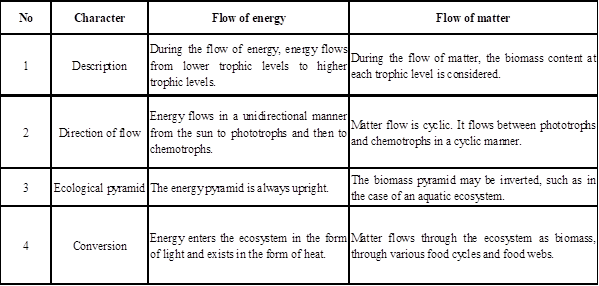
Concept explainers
How do phototrophs and chemotrophs depend intimately on each other? How does the flow of energy differ from the flow of matter?
To determine: How phototrophs and chemotrophs depend intimately on each other.
Introduction: All organisms derive their energy from the sunlight through direct or indirect methods. Phototrophs and chemotrophs are classified depending on the sources from which they derive their energy.
Explanation of Solution
Phototrophs are organisms which derive their energy directly from the sun. They have pigments that can absorb light. This light energy is converted to chemical energy and stored in the form of the energy currency of the cell that is ATP. Chemotrophs are organisms that derive their energy from the oxidation of electron donors in organic and inorganic molecules and use it for their processes. Following are the ways in which phototrophs and chemotrophs depend on each other:
- When light energy is not available, photoautotrophs need to act as chemotrophs so that they can continue to obtain energy.
- Even for the parts of the plant which are not exposed to the sunlight, their function as chemotrophs is necessary. Hence, most plants have both phototrophic as well as chemotrophic cells.
- Another way in which phototrophs depend on chemotrophs is that phototrophs need carbon sources other than carbon dioxide. They obtain these from chemotrophic organisms such as purple non-sulfur bacteria and green non-sulfur bacteria.
- Chemoheterotrophs are unable to produce their own food and thus they require food produced from phototrophs.
Thus, phototrophs and chemotrophs depend intimately on each other.
To determine: How the flow of energy differs from the flow of matter.
Introduction: All organisms derive their energy from the sunlight through direct or indirect methods. Phototrophs and chemotrophs are classified depending on the sources from which they derive their energy. The energy and mass flows through the ecosystem in a balanced way.
Explanation of Solution
The flow of energy differs from the flow of matter in following ways:

Phototrophs capture the light energy and convert it into chemical energy. This is them cycled throughout the system and gets converted into various forms. Photosynthesis and respiration are means by which energy flows through the different cycles. Finally, energy leaves a food chain in the form of heat. The organic matter produced by plants serves as the primary biomass for heterotrophs. This is how the flow of matter occurs in the ecosystem. The cycle is complete by decomposers, which convert organic biomass back into inorganic form.
Thus, the flow of energy and the flow of matter are interconnected and manage how mass and energy flows through different food cycles and trophic levels of the ecosystem.
Want to see more full solutions like this?
Chapter 5 Solutions
Becker's World of the Cell (9th Edition)
- Why can phototrophic green bacteria grow at light intensitiesthat will not support purple bacteria?arrow_forwardWhat do photosynthetic autotrophs use as a carbon source? What do the use as an energy source?arrow_forwardWhat accessory pigments are present in phototrophs,and what are their functions?arrow_forward
- What is the special name of photosynthetic parenchyma cells? Which organelle is especially abundant in these? How does wall thinness affect carbon dioxide and light?arrow_forwardWhich of the phototrophs discussed perform anoxygenic photosynthesis? Which are also capable of chemoorganoheterotrophy?arrow_forwardWhat is the advantage of the C4 photosynthetic pathway as compared to the conventional C3pathway? How might these advantages influence where these plant species are found?arrow_forward
- Explain the similarities and differences between phototrophy and chemotrophy.arrow_forwardName several examples of photoautotrophs and several of heterotrophs. How do photoautotrophs obtain energy? Can a plant be heterotrophic while a seedling and photoautotrophic when older?arrow_forwarddescribe the phosophorous cycle how do humans interrupt the Phosphorous Cycle and does it have atmospheric components?arrow_forward
 Human Anatomy & Physiology (11th Edition)BiologyISBN:9780134580999Author:Elaine N. Marieb, Katja N. HoehnPublisher:PEARSON
Human Anatomy & Physiology (11th Edition)BiologyISBN:9780134580999Author:Elaine N. Marieb, Katja N. HoehnPublisher:PEARSON Biology 2eBiologyISBN:9781947172517Author:Matthew Douglas, Jung Choi, Mary Ann ClarkPublisher:OpenStax
Biology 2eBiologyISBN:9781947172517Author:Matthew Douglas, Jung Choi, Mary Ann ClarkPublisher:OpenStax Anatomy & PhysiologyBiologyISBN:9781259398629Author:McKinley, Michael P., O'loughlin, Valerie Dean, Bidle, Theresa StouterPublisher:Mcgraw Hill Education,
Anatomy & PhysiologyBiologyISBN:9781259398629Author:McKinley, Michael P., O'loughlin, Valerie Dean, Bidle, Theresa StouterPublisher:Mcgraw Hill Education, Molecular Biology of the Cell (Sixth Edition)BiologyISBN:9780815344322Author:Bruce Alberts, Alexander D. Johnson, Julian Lewis, David Morgan, Martin Raff, Keith Roberts, Peter WalterPublisher:W. W. Norton & Company
Molecular Biology of the Cell (Sixth Edition)BiologyISBN:9780815344322Author:Bruce Alberts, Alexander D. Johnson, Julian Lewis, David Morgan, Martin Raff, Keith Roberts, Peter WalterPublisher:W. W. Norton & Company Laboratory Manual For Human Anatomy & PhysiologyBiologyISBN:9781260159363Author:Martin, Terry R., Prentice-craver, CynthiaPublisher:McGraw-Hill Publishing Co.
Laboratory Manual For Human Anatomy & PhysiologyBiologyISBN:9781260159363Author:Martin, Terry R., Prentice-craver, CynthiaPublisher:McGraw-Hill Publishing Co. Inquiry Into Life (16th Edition)BiologyISBN:9781260231700Author:Sylvia S. Mader, Michael WindelspechtPublisher:McGraw Hill Education
Inquiry Into Life (16th Edition)BiologyISBN:9781260231700Author:Sylvia S. Mader, Michael WindelspechtPublisher:McGraw Hill Education





